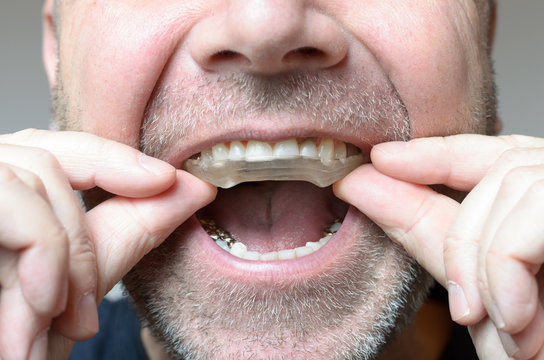
Bite plates are orthodontic appliances designed to address various oral health issues, from teeth grinding to bite misalignment. Whether you’re experiencing discomfort from bruxism or seeking support during orthodontic treatment, understanding the role of bite plates can significantly enhance your dental care journey. These custom-fitted devices not only protect your teeth but also may play a crucial role in realigning your jaw and alleviating pain associated with conditions like temporomandibular joint (TMJ) disorders.Let’s explore what bite plates are, how they work, their benefits, and the different types available.
What is a bite plate?
A bite plate is a specialised dental appliance designed to help manage and correct various bite-related issues. Typically custom-made, it fits over or behind the upper or lower teeth, serving several important functions in orthodontic treatment.
Bite plates are primarily utilised to address conditions such as deep overbites, where the upper teeth significantly overlap the lower teeth, potentially leading to discomfort and other oral health problems if left untreated. Their key functions include:
- Protecting teeth
- Aiding orthodontic correction
- Relieving TMJ pain
- Facilitating proper jaw growth
How does a bite plate work?
Bite plates work by applying gentle pressure to specific areas of the jaw and teeth, facilitating realignment and providing protection against damage caused by bruxism (teeth grinding) or other dental issues. When worn, these appliances help stabilise the jaw in a more comfortable position, allowing for gradual adjustments that can alleviate discomfort and improve overall dental health.
Mechanisms of Bite Plates:
- Realigning the Jaw: Encourages movement into a more natural alignment, beneficial for overbites or underbites.
- Protecting Teeth: Prevents direct contact between upper and lower teeth, reducing wear and tear.
How long should you use a bite plate?
Although bite plates are designed for continuous wear, many dentists recommend removing them during meals to prevent food buildup and maintain hygiene. Standard wear time ranges from 2 to 6 months, depending on individual treatment plans.
Benefits of using a bite plate

1. Alleviating Bruxism (teeth grinding)
Bite plates are particularly effective in preventing the damage caused by bruxism, which involves the involuntary grinding of teeth or jaw clenching, often occurring during sleep. Bite plates absorb the forces generated during grinding by creating a physical barrier. This helps to:
- Protect Tooth Enamel: The bite plate prevents direct contact between teeth, reducing wear on enamel and minimising the risk of fractures or chips.
- Reduce Jaw Tension: By cushioning the impact of grinding, bite plates help relax the jaw muscles, alleviating tension and discomfort that can lead to headaches and facial pain.
- Prevent Long-Term Tooth Damage: Regular use of a bite plate can limit the progression of dental issues associated with bruxism, such as tooth decay and periodontal problems.
2. Supporting orthodontic treatments
Bite plates also help to correct misaligned teeth, such as overbites and underbites. They work by:
- Guiding jaw positioning: By applying consistent pressure, bite plates encourage the jaw to move into a more natural alignment, which is crucial for effective orthodontic treatment.
- Facilitating orthodontic procedures: They can prepare the patient’s mouth for further orthodontic interventions, ensuring that braces or other devices fit more effectively.
- Improving overall bite function: By addressing misalignments early on, bite plates can enhance chewing efficiency and reduce strain on the jaw joints.
3. Relieving TMJ pain
Bite plates can help alleviate the pain of muscle tension and joint strain from temporomandibular joint (TMJ) disorders by:
- Redistributing pressure: The appliance helps distribute biting forces evenly across the jaw, reducing stress on the TMJ and surrounding muscles.
- Easing muscle tension: By providing a cushion between the teeth, bite plates can relax jaw muscles, leading to decreased pain and improved function.
- Enhancing quality of life: With reduced pain and discomfort, individuals may experience improved sleep quality and overall well-being.
Types of bite plates
There are primarily two categories of bite plates: soft and hard, as well as a distinction between custom-fitted and over-the-counter options.
1. Soft bite plates
Soft bite plates are made from flexible materials, typically a type of durable plastic that provides cushioning. These devices are designed for comfort and are often recommended for individuals with mild bruxism or those who require gentle support for jaw alignment.
2. Hard bite plates
Hard bite plates are constructed from rigid materials, offering a more robust solution for severe dental issues. They are particularly suitable for patients who experience significant grinding or have TMJ disorders.
3. Custom vs. over-the-counter bite plates
Bite plates can be categorised into custom-fitted options and over-the-counter (OTC) alternatives, each with its own advantages and disadvantages.
- Custom-fitted options:
- Pros:
- Tailored to the individual’s dental structure, ensuring a precise fit.
- Typically, it is more comfortable and effective in addressing specific dental issues.
- Greater durability and effectiveness in orthodontic treatment.
- Cons:
- Requires visits to a dental professional for fitting and adjustments.
- Pros:
- Over-the-counter options:
- Pros:
- Generally more affordable and readily available without a prescription.
- Convenient for temporary use or mild cases of bruxism.
- Cons:
- It may not fit as well, leading to discomfort or reduced effectiveness.
- Limited in addressing complex orthodontic issues compared to custom options.
- Pros:
How to choose the right bite plate
Selecting the appropriate bite plate involves considering several factors, including the material, intended purpose, and cost.
Material
The material of the bite plate significantly affects its comfort, durability, and effectiveness. Common materials include:
- Acrylic: Often used for both soft and hard bite plates, acrylic is durable yet lightweight, making it comfortable for prolonged wear.
- Plastic: Soft bite plates are typically made from flexible plastic that provides cushioning for mild bruxism.
- Metal components: Some bite plates incorporate metal clasps or wires for added stability, particularly in fixed options.
Purpose
The intended use of the bite plate is another critical factor to consider:
- Bruxism management: For individuals who grind their teeth, a soft or hard bite plate may be recommended to protect teeth from damage.
- Orthodontic correction: Bite plates designed for correcting overbites or underbites will need to be more rigid and custom-fitted to ensure proper alignment.
- TMJ relief: If the primary concern is jaw pain or tension, a bite plate that redistributes pressure on the jaw joints may be ideal.
| Condition | Recommended Type | Material |
|---|---|---|
| Mild Bruxism | Soft Bite Plate | Flexible Plastic |
| Severe Bruxism | Hard Bite Plate | Acrylic |
| Overbite/Underbite | Custom-Fitted Bite Plate | Acrylic/Metal |
| TMJ Disorders | Custom-Fitted Hard Plate | Acrylic |
How to care for a bite plate
Proper care and maintenance of your bite plate not only helps maintain oral hygiene but also prevents bacteria buildup that can lead to infections or unpleasant odours. Here’s a guide on how to effectively care for your bite plate.
Cleaning and maintenance
To keep your bite plate in optimal condition, follow these cleaning techniques:
- Daily cleaning:
- Rinse your bite plate with warm water immediately after use to remove debris and prevent plaque buildup.
- Use a soft-bristled toothbrush dedicated solely to cleaning your bite plate. Avoid using the same toothbrush you use for your teeth to prevent cross-contamination.
- Clean with a mild, non-abrasive soap or alcohol-free mouthwash on the toothbrush and gently brush all surfaces, including crevices.
- Deep cleaning:
- At least once a month, soak your bite plate in an over-the-counter (OTC) denture cleaner or a solution of vinegar and hydrogen peroxide in equal parts for about 30 minutes. Rinse thoroughly afterwards.
- Consider using effervescent cleaning tablets designed for dental appliances, which can help remove stubborn debris and bacteria.
Storing your bite plate
Proper storage helps prevent damage and maintain hygiene:
- Always store your bite plate in its protective case when not in use. This helps keep it safe from dust, bacteria, and accidental damage.
- Ensure the case is clean; regularly wash it with soap and water to minimise bacterial growth.
- Allow the bite plate to air dry completely before placing it in the storage case, as moisture can promote bacterial growth.
When to replace your bite plate
Regularly inspect your bite plate for signs of wear or damage, such as:
- Cracks or chips in the material.
- Discolouration or an unpleasant odour that persists despite cleaning.
- A noticeable change in fit indicates that it may no longer provide adequate support.
If you notice any of these signs, consult your orthodontist to assess the condition of your bite plate and ensure it continues to meet your dental needs effectively.
Do bite plates hurt?

When first using a bite plate, some discomfort is common. Patients may feel soreness in their teeth and gums from the pressure exerted by the bite plate on the teeth and jaw.
- Adjustment period: Most patients find that any soreness or tenderness subsides within a few days to a week if they wear the bite plate consistently. It is important to adhere to wearing instructions, as taking the plate out frequently can prolong the adjustment period.
- Pain management: If discomfort persists, mild pain relievers can be used, and soft foods are recommended during the initial adjustment phase. If severe pain occurs, it is advisable to consult a dental professional for adjustments.
How much do bite plates cost?
In Australia, custom bite plates typically cost between $300 and $600. These are tailored specifically to an individual’s dental structure, providing optimal comfort and effectiveness.
Can I eat with a bite plate?
Bite plates are designed to be worn continuously, including during meals. However, many dental professionals recommend removing the bite plate while eating to prevent food particles from becoming trapped between the plate and teeth. This practice also helps maintain better oral hygiene and prevents damage to the bite plate itself.
If you choose to eat with your bite plate in place, it is advisable to consume softer foods or smaller pieces to minimise discomfort while chewing.
Alternatives to bite plates
For individuals seeking alternatives to bite plates, several options may be more appropriate depending on their specific dental needs.
Night guards
Night guards are similar appliances primarily designed for bruxism management. They protect teeth from grinding during sleep but do not typically address alignment issues like bite plates do.
Retainers and splints
Retainers are generally used after orthodontic treatment to maintain tooth position, while splints are often used for TMJ disorders to alleviate jaw pain.
Conclusion
Bite plates effectively manage bruxism, correct bite misalignment, and relieve TMJ pain. While an adjustment period is expected, proper use and care ensure maximum comfort and benefits.
For those seeking alternatives, night guards, retainers, and splints offer additional solutions tailored to specific dental needs. Consult with your orthodontist to determine the right approach.
